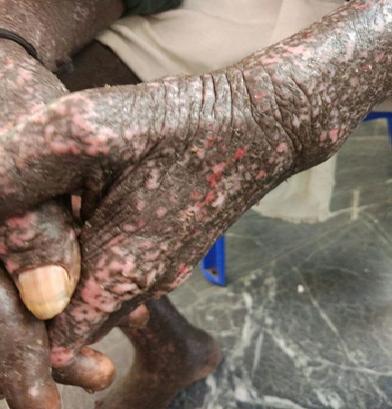
Diclofenac - Serratiopeptidase Combination Induced Exfoliative Dermatitis: A Case Report
Abstract
Exfoliative dermatitis (ED) is an inflammatory
dermatosis involving more than 90% of body surface
area. It is caused by exposure to drugs and cause
significant morbidity and mortality. Diclofenac and
Serratiopeptidase are documented as a cause in inducing
Exfoliative Dermatitis. A careful literature search
revealed that only a few reports of diclofenac induced
and one case of serratiopeptidase associated case
report of Stevens-Johnson syndrome (SJS) or toxic
epidermal necrolysis (TEN) have been published till date.
However, to our knowledge, no case report of
diclofenac-serratiopeptidase combination induced ED have
been published till date from southern part of Tamilnadu.
Hence we describe the first case of a 65 year old male who
developed progressive rashes and blisters over the limb
extremities following intake of diclofenac and
serratiopeptidase combination.
A provisional diagnosis of Exfoliative dermatitis was
made by the treating physician. After administration of
Tablet prednisolone 10 mg twice daily, tablet paracetamol
500 mg thrice daily and topical application of
betamethasone cream with glycerine lotion on the affected
area thrice daily, patient recovered and was discharged.
Causality analysis on the World Health Organization scale
indicates a probable association with offending drugs.
Full Text:
PDFReferences
Nayak S, Acharjya B. Adverse cutaneous drug reaction.
Indian J Dermatol. 2008;53(1):2–8.
Freedberg IM. Exfoliative dermatitis. In: Fitzpatrick TB, Eisen
AZ, Wolff K, Freedberg IN, Austen KF, eds. Dermatology in
General Medicine. 5th ed. New York: McGraw Hill; 1999.
p.534-7.
Estrada R, Sanmartin O, Oliver V, Febrer I, Aliaga A.
Erythroderma. A clinicopathological study of 56 cases. Arch
Dermatol. 1999;130:508-13.
Drug induced exfoliative dermatitis: state of the art
Mona Rita Yacoub, Alvise Berti, Corrado Campochiaro,
Enrico Tombetti, Giuseppe Alvise Ramirez, Andrea Nico,
Elisabetta Di Leo, Paola Fantini, Maria Grazia Sabbadini,
Eustachio Nettis and Giselda Colombo Clinical and Molecular
Allergy 2016 14:9
Gor AP, Shah BK. Evaluation of prescribing pattern and
adverse effects of fixed dose combination of non-steroidal
antiinflammatory drugs. Int J Basic Clin Pharmacol
;5:1029-33.
Diclofenac potassium. http://www.drugs.com/pro/diclofenacpotassium.
html (accessed on 7th Feb’2014).
Mazzone A, Catalani M, Constanzo M, Drusian A, Mandoli
A, Russo S, et al. Evaluation of Serratia peptidase in acute or
chronic inflammation of otorhinolaryngolog pathology:
a multicentre, double-blind, randomized trial versus placebo.
J Int Med Res. 1990,18(5):379-88.
The use of the WHO-UMC system for standardised case
causality assessment. Available from: http://www.
WHO-UMC.org/graphics/4409.pdf (Last accessed on 2013 Dec
.D08-YD11.
Exfoliative dermatitis: clinical and etiologic study of
cases. Kondo RN, Gon AS, Minelli L, Mendes MF,
Pontello R.An Bras Dermatol. 2006;81(3):233-7.
Hoeger PH, Adwani SS, Whitehead BF, Finlay AY,
Harper JI. Ichthyosiform erythroderma and
cardiomyopathy: report of two cases and review of the
literature.Br J Dermatol. 1998;139:1055-9.
Pal S, Haroon TS. Erythroderma: a clinico-etiologic
study of 90 cases. Int J Dermatol. 1998;37:140-7.
Burton JL. Erythroderma. In: Rook AJ, Champion RH,
Burton JL, Ebling FJG, eds. Textbook of Dermatology. 5th
ed. Oxford: Blackwell Scientific Publications; 1992. p.584-8.
Refbacks
- There are currently no refbacks.

This work is licensed under a Creative Commons Attribution-NoDerivatives 4.0 International License.
An initiative of The Tamil Nadu Dr M.G.R. Medical University